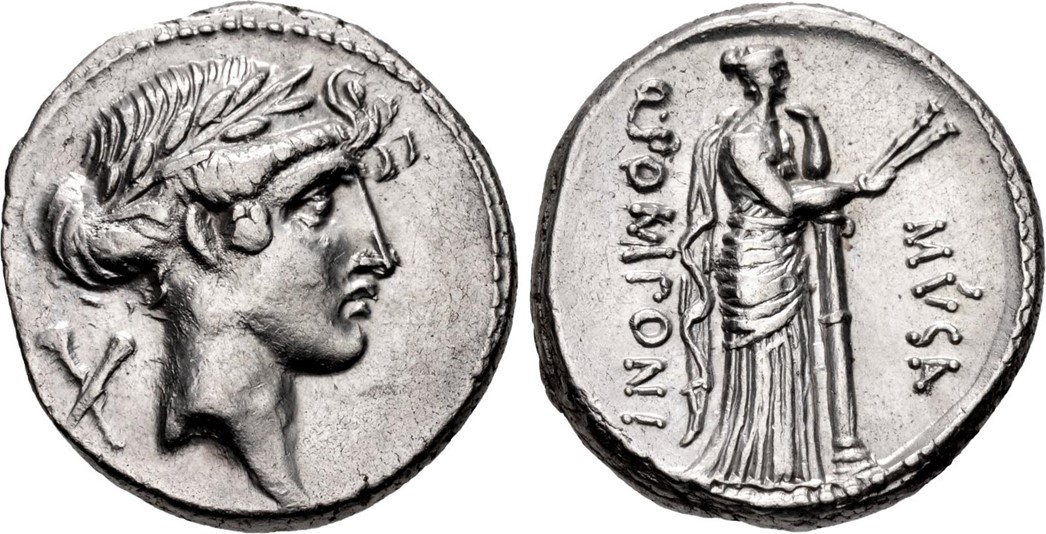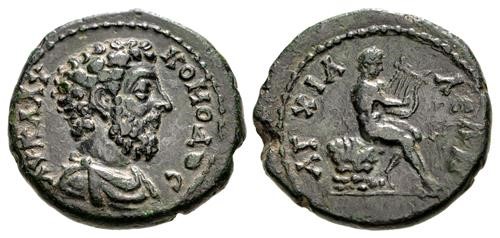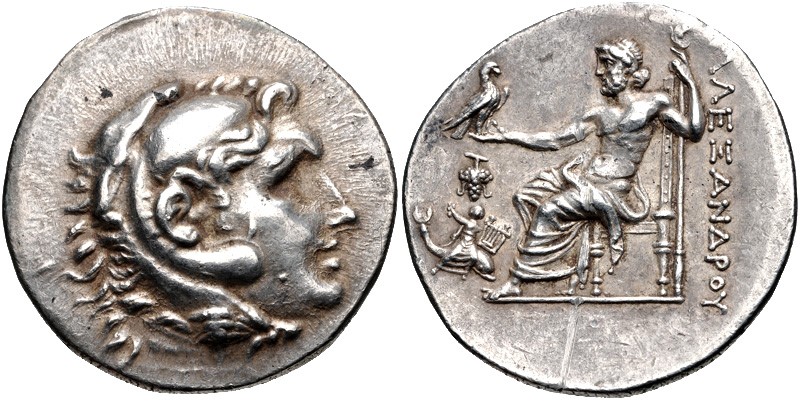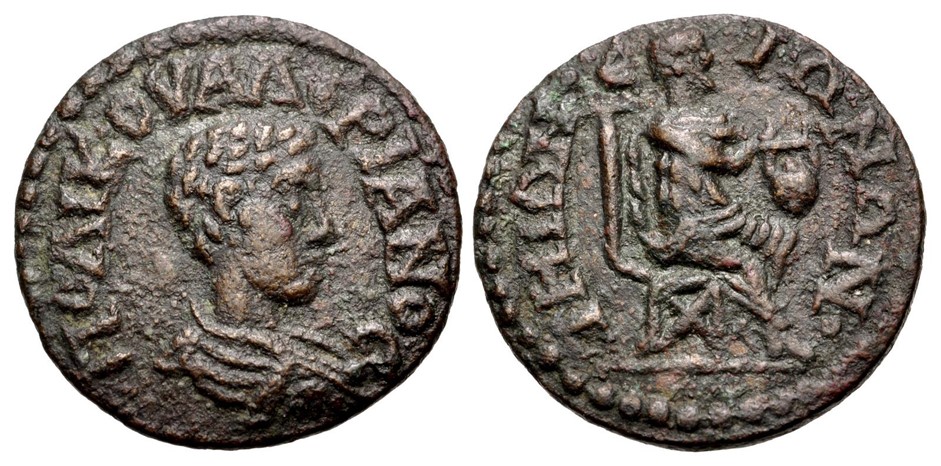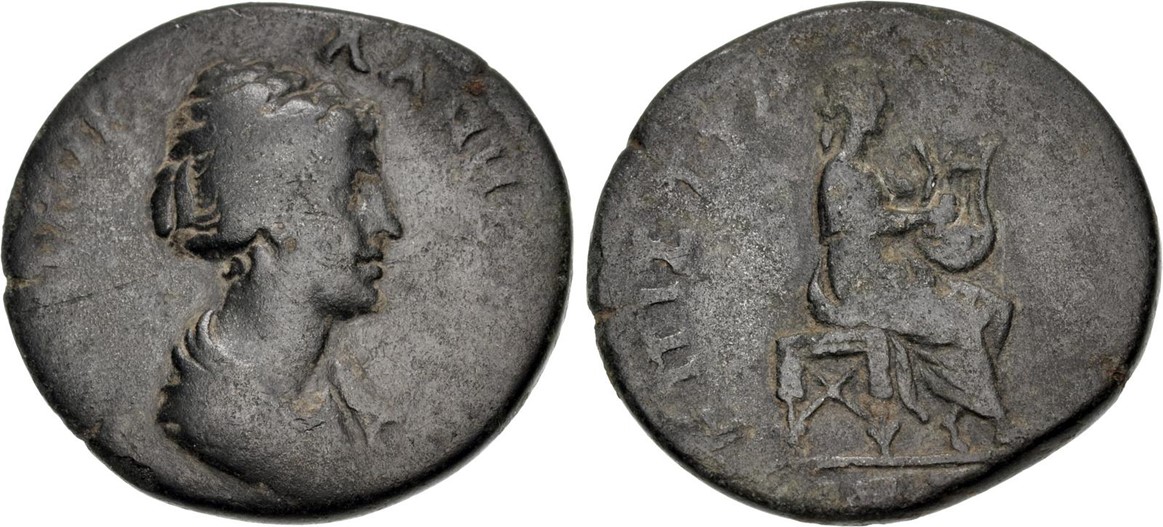NGC Ancients: Writing and the Muses
Posted on 11/12/2024
November is National Novel Writing Month (NaNoWriMo), a worldwide event that challenges aspiring authors to write a manuscript before the month is over. For such a daunting task, a writer might turn to a muse — something to inspire him or her. Muses are rooted in ancient Greek mythology, and NaNoWriMo has inspired us to devote an NGC Ancients column to them.
In 56 B.C., Roman moneyer Quintus Pomponius Musa issued a series of silver denarii featuring the muses, cleverly taking advantage of a word that sounds similar to his own name. The reverse of this coin depicts Calliope, the muse of epic poetry. She is regarded as the chief of the muses and is shown here playing a lyre.
All obverses in the series show a portrait of the god Apollo, behind which is a symbol appropriate to the muse depicted on the reverse. On the coin devoted to Calliope, it is a key used to tune a lyre.
This denarius from the Muses series shows Clio, the muse of history, reading a scroll; a scroll also appears behind Apollo. Temples called “mouseion” were built to the muses, and often became centers of learning. For instance, in Ptolemaic Egypt, the Mouseion of Alexandria attracted some of the greatest scholars of the world in the 3rd and 2nd Centuries B.C. The word "museum" is derived from mouseion.
Erato, the muse of erotic poetry, holds a lyre, on this denarius. Her symbol on the obverse is a flower. The muses are the children of Zeus, the chief of the Olympian gods.
Euterpe, the muse of song, holding two tibiae (a wind instrument) is depicted on this denarius; two flutes are shown behind Apollo. Whether he intended to or not, the moneyer Musa created a collector’s set of silver denarii, similar to the popular State Quarters Program in the United States that served as a challenge to collect all 50 states from circulation.
Melpomene, the muse of tragic theatre, holding a mask and club while armed with a sword, appears on this denarius, which also shows a scepter behind Apollo. In some accounts, she is the mother of the treacherous sirens, who use their beautiful voices to lure sailors to their ruin.
Polymnia, the muse of sacred hymns, poetry and dance, is shown wearing a long tunic; a wreath appears behind Apollo’s head. Her name and modern words such as “hymnal” derive from the Greek word for praise. And the word "music" comes to us from the ancient Greek word for muse.
Terpsichore, the muse of dance, is depicted with a lyre on this denarius. On the obverse, a tortoise appears behind Apollo, who, as the god of music and the arts, is regarded as the leader of the muses.
Thaila, the muse of comedy, is shown on this denarius holding a comic mask while leaning on a column. The symbol of a laughing mask and crying mask together is sometimes used to represent the performing arts, and it is derived from the masks of Melpomene and Thalia. A sandal is shown behind Apollo.
Urania, the muse of astronomy, is shown on this denarius holding a wand toward a globe; a star appears behind Apollo. While some ancient sources said there were only three muses, the ancient poets Homer and Hesiod established the number as nine. The muses’ names and areas of specialty also varied in antiquity.
The final denarius we’ll illustrate from the series shows Hercules Musagetes, conductor of the Muses. The legendary hero, who had a strong following in the ancient world, is shown playing the lyre and wearing the skin of the Nemean lion. Rome’s Temple of Hercules Musarum was built in 189 B.C., shortly after a Roman consul conquered the Greek city of Ambracia. Among the plunder placed in the Roman temple was a group of statues of the Muses, which may have served as the inspiration for this series of denarii.
This base-metal coin struck under Roman Emperor Commodus (AD 177-192) from Anchialus in Thrace likely shows legendary musician Orpheus playing a lyre. Accounts vary, but the ancient Greek poet Pindar calls Orpheus the son of the muse Calliope and Oeagrus, the king of Thrace. Orpheus mastered the lyre, and his music was said to have been so powerful that it could charm wild animals and make trees dance.
There are a few instances of poets being immortalized on coinage struck in their native land. This silver tetradrachm of Methymna, on the island of Lesbos, is an example. It was struck late in the third century B.C. and before the seated figure of Zeus shows the poet Arion riding a dolphin and holding a lyre-like instrument called a cithara. The imagery is from a myth that he was rescued from death at sea by a dolphin. A native of Methymna, Arion was credited with inventing a type of hymn called the dithyramb.
The poet Anacreon is shown on this base-metal Roman coin of his native Teos in Ionia, struck under Valerian II as Caesar (AD 256-58). Anacreon lived in the 6th century BC and is regarded as one of the Nine Lyric Poets, a group of Greek masters who lived around his time who were regarded as worthy of study. His poems were meant for soloists, and covered themes of love and celebration that resonated with the average person.
The only woman among the Nine Lyric Poets was Sappho of Lesbos, who is depicted on this base-metal Roman coin struck in the mid-1st century AD at Mytilene, on Lesbos. Sappho’s poetry was so extraordinary that she earned a reputation as the “Tenth Muse.” The obverse shows Julia Procula, who was apparently an important patron of this city.
Stesichorus of Metauros, another of the Nine Lyric Poets, is shown writing on a tablet on the reverse of this base-metal coin issued c. 200-150 BC in Himera, Sicily, where he moved later in life. The obverse shows Tyche, a deity who determined whether or not a city prospered.
Roman Emperor Nero (AD 54-68) was, among other things, an aspiring poet and musician. This copper As shows his portrait opposite a striding figure of himself in the guise of Apollo Citharoedus. The tyrannical Nero liked to personally recite poetry at parties, which was frowned upon as unbecoming of an emperor. He survived an assassination attempt in AD 65 that was organized, in part, by members of his court, including fellow poets Lucan and Petronius, as well as dramatist Seneca the Younger. In the aftermath, all were forced to kill themselves. In AD 68, as the increasingly erratic Nero lost the support of the military, he prepared to kill himself, declaring “What an artist the world is losing!” Little of his poetry survives, but contemporaneous opinions about his writing skills were mixed at best.
Byzantine Empress Aelia Eudocia is shown on this gold solidus struck in the AD 420s. She had been raised as a pagan and given an advanced education in Greece by father, who was a philosophy instructor. Upon her marriage to the emperor in 421, she became a devout Christian. For reasons that are unclear, the emperor banished the empress from Constantinople, and she moved to Jerusalem around 443, where she focused on her writing until her death in 460. Her poetry offers fascinating insights into the early Hellenistic Christian world. Today, she is regarded as a saint in the Eastern Orthodox Church.
Images courtesy of Classical Numismatic Group.
Related Link: More NGC Ancients columns
Stay Informed
Want news like this delivered to your inbox once a month? Subscribe to the free NGC eNewsletter today!



